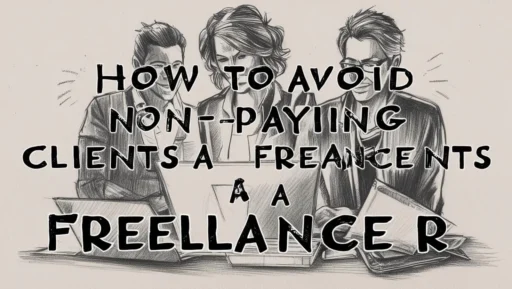Every freelancer knows the feeling: the exhilaration of completing a project, delivering fantastic work, and sending off the final invoice. But then, silence. Days turn into weeks, and the initial pride sours into a sinking feeling of dread. This is the freelancer’s nightmare—being ghosted when it’s time to get paid.
A non-paying client is far more than a simple annoyance; they are a direct threat to the viability of your business. Unpaid invoices don’t just sabotage your cash flow and disrupt your budget; they represent stolen time. Every hour you spent on that project, and every subsequent hour you spend chasing the payment, is time you could have dedicated to great, paying clients. The psychological toll can be just as damaging, eroding your motivation, breeding cynicism, and making you hesitant to trust the next new client. While the vast majority of clients are honest and professional, even one non-payer can cause significant harm. Fortunately, you don’t have to leave it to chance. By implementing a proactive defense system of processes and precautions, you can significantly minimize your risk and learn to handle any payment issue with confidence and professionalism.
Warning Signs of Potential Non-Paying Clients
The best way to deal with a non-paying client is to never work with them in the first place. Learning to spot the red flags during the initial conversations is a critical skill. Trust your instincts—if a potential client makes you feel uneasy, there’s usually a good reason.
Be cautious with clients who:
- Refuse to sign a formal contract. This is the biggest red flag. A contract protects both parties. A client who resists signing one may be intentionally keeping the terms vague and unenforceable. They might offer excuses like, “We’re a startup, we like to move fast,” or “It’s just a small project, we don’t need all that paperwork.” Treat a contract as non-negotiable.
- Hesitate or refuse to pay an upfront deposit. A deposit is more than just an initial payment; it’s a test of the client’s seriousness and financial commitment. It ensures they have “skin in the game” from day one. A client who won’t pay a deposit is a high-risk client.
- Are vague about requirements or constantly change the scope. Clients who don’t know what they want often don’t know what it’s worth. This vagueness can lead to endless revisions (“scope creep”) and becomes a convenient excuse for them to dispute the final invoice.
- Haggle excessively on price. A client who questions and tries to negotiate down every part of your proposal before the project even begins is signaling that they don’t fully value your work. This behavior often continues when the final bill is due.
- Have no professional online presence. In today’s digital world, a legitimate business or professional should be verifiable. A lack of a professional website, an empty LinkedIn profile, or no verifiable business information should make you extremely cautious.
- Communicate poorly or unprofessionally. If a client is slow to respond, provides one-word answers, or is generally difficult to communicate with from the start, imagine how they’ll behave when you’re asking for money.
Essential Protective Steps Before You Start Any Work
A few proactive measures at the beginning of a project can save you from a massive headache at the end. Think of these as your business’s insurance policy.
1. Always, Always Use a Contract
Your contract is the single most important document in any freelance project. It is not an aggressive tactic; it is a mark of a professional. Ensure both you and the client have signed it before you write a single word or design a single pixel. Your contract should clearly detail:
- A detailed Scope of Work: What you will deliver.
- Deliverables and Deadlines: When you will deliver it.
- Payment Terms: How much and when you will be paid (e.g., 50% deposit, 50% upon completion).
- Revision Rounds: The number of revisions included in the price.
- Late Fee Policy: A clause stating that a fee (e.g., 5% per month) will be applied to overdue invoices.
- Intellectual Property: A clause stating that you retain ownership of the work until final payment is received.
2. Request a Meaningful Upfront Deposit
Never start work without a deposit from a new client. It solidifies their commitment and protects you if they disappear.
- For smaller projects (under $2,000): A 50% upfront deposit is standard.
- For larger, long-term projects: Structure milestone payments. For example: 30% deposit to start, 30% upon delivery of the first draft, and 40% upon final completion.
- The Golden Rule: Do not start working until the deposit has cleared in your bank account.
3. Use Secure and Traceable Payment Methods
Make it easy for clients to pay you, but do so in a way that protects you. Clearly state your accepted payment methods in your contract and on your invoices.
- Good Options: Stripe, PayPal, Wise, or direct bank transfers provide a digital paper trail.
- Platforms: Sites like Upwork have built-in escrow systems that hold the client’s funds and release them to you upon milestone approval, offering excellent protection.
- Methods to Avoid: Be wary of clients who insist on paying by check (which can bounce) or untraceable methods like cash or Western Union.
What to Do If a Client Fails to Pay
Even with the best precautions, you may eventually face an overdue invoice. Handle it with a calm, systematic process. Do not get emotional; get methodical.
Step 1: The Polite Nudge (1-3 Days After Due Date) Send a brief, friendly email. Assume it was an oversight. Subject: Friendly Reminder: Invoice #123 “Hi [Client Name], just a friendly reminder that invoice #123 was due on [Date]. You can view and pay it here: [Link]. Please let me know if you have any questions. Thanks!”
Step 2: The Firm Follow-Up (7-10 Days After Due Date) Your tone should remain professional but become more direct. Subject: Overdue: Invoice #123 “Hi [Client Name], I’m following up on invoice #123 for [Amount], which is now one week overdue. Per our contract, prompt payment is required for the project to continue. Please let me know when I can expect to receive payment. Best,”
Step 3: Stop Work and Issue a Final Notice (15-30 Days After Due Date) At this stage, you must protect yourself from doing any further work for free. Subject: URGENT: Invoice #123 is 30 Days Overdue – Work Halted “Hi [Client Name], this is a final notice that invoice #123 is now 30 days past due. As per our contract, a late fee of [Amount] has been applied. All work on your project has been suspended until the outstanding balance of [New Total Amount] is settled. If payment is not received by [Final Date], this matter will be escalated. Regards,”
Step 4: Last Resorts If the client still refuses to pay, you can consider a collection agency or filing a claim in small claims court. However, always weigh the unpaid amount against the time, cost, and stress of pursuing legal action. Often, the best move is to write it off as a lesson learned and focus your energy on finding better clients.
The Bottom Line: Work Smart, Get Paid
Protecting yourself from non-paying clients is not about being cynical or distrustful. It’s about operating as a serious business owner. By implementing clear contracts, requiring deposits, vetting clients, and maintaining professional communication, you send a powerful message: you are a professional, your time is valuable, and you expect to be compensated for your work. These practices will not only secure your income but will also attract higher-quality clients who respect your process and your expertise.
“The best way to ensure payment is by having solid contracts for freelancers.”

